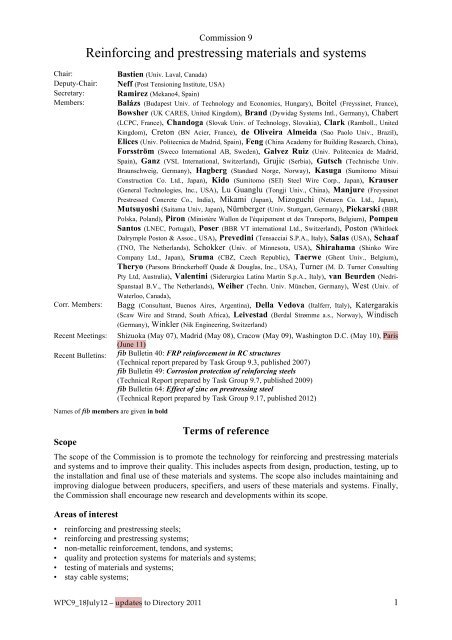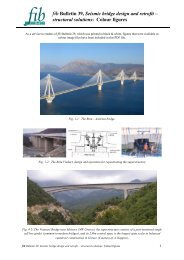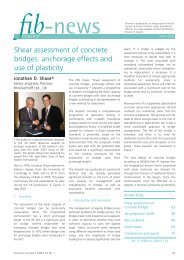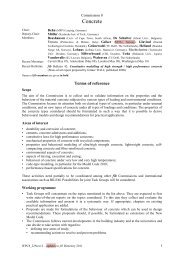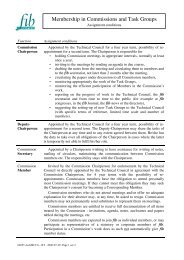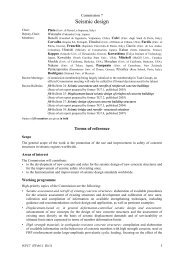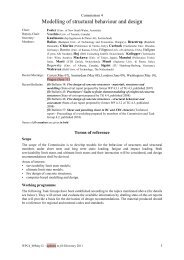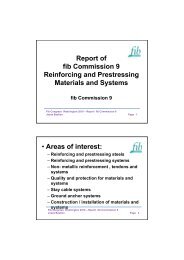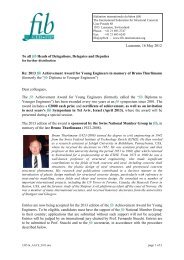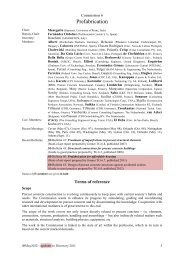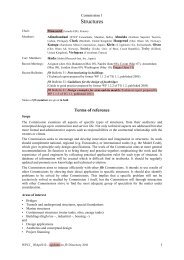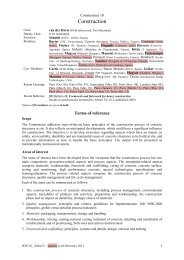Reinforcing and prestressing materials and systems - The ...
Reinforcing and prestressing materials and systems - The ...
Reinforcing and prestressing materials and systems - The ...
Create successful ePaper yourself
Turn your PDF publications into a flip-book with our unique Google optimized e-Paper software.
Commission 9<br />
<strong>Reinforcing</strong> <strong>and</strong> <strong>prestressing</strong> <strong>materials</strong> <strong>and</strong> <strong>systems</strong><br />
Chair: Bastien (Univ. Laval, Canada)<br />
Deputy-Chair: Neff (Post Tensioning Institute, USA)<br />
Secretary: Ramirez (Mekano4, Spain)<br />
Members: Balázs (Budapest Univ. of Technology <strong>and</strong> Economics, Hungary), Boitel (Freyssinet, France),<br />
Bowsher (UK CARES, United Kingdom), Br<strong>and</strong> (Dywidag Systems Intl., Germany), Chabert<br />
(LCPC, France), Ch<strong>and</strong>oga (Slovak Univ. of Technology, Slovakia), Clark (Ramboll., United<br />
Kingdom), Creton (BN Acier, France), de Oliveira Almeida (Sao Paolo Univ., Brazil),<br />
Elices (Univ. Politecnica de Madrid, Spain), Feng (China Academy for Building Research, China),<br />
Forsström (Sweco International AB, Sweden), Galvez Ruiz (Univ. Politecnica de Madrid,<br />
Spain), Ganz (VSL International, Switzerl<strong>and</strong>), Grujic (Serbia), Gutsch (Technische Univ.<br />
Braunschweig, Germany), Hagberg (St<strong>and</strong>ard Norge, Norway), Kasuga (Sumitomo Mitsui<br />
Construction Co. Ltd., Japan), Kido (Sumitomo (SEI) Steel Wire Corp., Japan), Krauser<br />
(General Technologies, Inc., USA), Lu Guanglu (Tongji Univ., China), Manjure (Freyssinet<br />
Prestressed Concrete Co., India), Mikami (Japan), Mizoguchi (Neturen Co. Ltd., Japan),<br />
Mutsuyoshi (Saitama Univ, Japan), Nürnberger (Univ. Stuttgart, Germany), Piekarski (BBR<br />
Polska, Pol<strong>and</strong>), Piron (Ministère Wallon de l'équipement et des Transports, Belgium), Pompeu<br />
Santos (LNEC, Portugal), Poser (BBR VT international Ltd., Switzerl<strong>and</strong>), Poston (Whitlock<br />
Dalrymple Poston & Assoc., USA), Prevedini (Tensacciai S.P.A., Italy), Salas (USA), Schaaf<br />
(TNO, <strong>The</strong> Netherl<strong>and</strong>s), Schokker (Univ. of Minnesota, USA), Shirahama (Shinko Wire<br />
Company Ltd., Japan), Sruma (CBZ, Czech Republic), Taerwe (Ghent Univ., Belgium),<br />
<strong>The</strong>ryo (Parsons Brinckerhoff Quade & Douglas, Inc., USA), Turner (M. D. Turner Consulting<br />
Pty Ltd, Australia), Valentini (Siderurgica Latina Martin S.p.A., Italy), van Beurden (Nedri-<br />
Spanstaal B.V., <strong>The</strong> Netherl<strong>and</strong>s), Weiher (Techn. Univ. München, Germany), West (Univ. of<br />
Waterloo, Canada),<br />
Corr. Members: Bagg (Consultant, Buenos Aires, Argentina), Della Vedova (Italferr, Italy), Katergarakis<br />
(Scaw Wire <strong>and</strong> Str<strong>and</strong>, South Africa), Leivestad (Berdal Strømme a.s., Norway), Windisch<br />
(Germany), Winkler (Nik Engineering, Switzerl<strong>and</strong>)<br />
Recent Meetings: Shizuoka (May 07), Madrid (May 08), Cracow (May 09), Washington D.C. (May 10), Paris<br />
(June 11)<br />
Recent Bulletins: fib Bulletin 40: FRP reinforcement in RC structures<br />
(Technical report prepared by Task Group 9.3, published 2007)<br />
fib Bulletin 49: Corrosion protection of reinforcing steels<br />
(Technical Report prepared by Task Group 9.7, published 2009)<br />
fib Bulletin 64: Effect of zinc on <strong>prestressing</strong> steel<br />
(Technical Report prepared by Task Group 9.17, published 2012)<br />
Names of fib members are given in bold<br />
Scope<br />
Terms of reference<br />
<strong>The</strong> scope of the Commission is to promote the technology for reinforcing <strong>and</strong> <strong>prestressing</strong> <strong>materials</strong><br />
<strong>and</strong> <strong>systems</strong> <strong>and</strong> to improve their quality. This includes aspects from design, production, testing, up to<br />
the installation <strong>and</strong> final use of these <strong>materials</strong> <strong>and</strong> <strong>systems</strong>. <strong>The</strong> scope also includes maintaining <strong>and</strong><br />
improving dialogue between producers, specifiers, <strong>and</strong> users of these <strong>materials</strong> <strong>and</strong> <strong>systems</strong>. Finally,<br />
the Commission shall encourage new research <strong>and</strong> developments within its scope.<br />
Areas of interest<br />
• reinforcing <strong>and</strong> <strong>prestressing</strong> steels;<br />
• reinforcing <strong>and</strong> <strong>prestressing</strong> <strong>systems</strong>;<br />
• non-metallic reinforcement, tendons, <strong>and</strong> <strong>systems</strong>;<br />
• quality <strong>and</strong> protection <strong>systems</strong> for <strong>materials</strong> <strong>and</strong> <strong>systems</strong>;<br />
• testing of <strong>materials</strong> <strong>and</strong> <strong>systems</strong>;<br />
• stay cable <strong>systems</strong>;<br />
WPC9_18July12 – updates to Directory 2011 1
• ground anchor <strong>systems</strong>;<br />
• execution/installation of the above mentioned <strong>materials</strong> <strong>and</strong> <strong>systems</strong> (in co-operation with<br />
Commission 10).<br />
Working programme<br />
Prestressing <strong>materials</strong> <strong>and</strong> <strong>systems</strong><br />
P2 Preparation of design guidelines for concrete structures reinforced, prestressed or strengthened<br />
with non-metallic FRP (Fibre Reinforced Polymers) reinforcement.<br />
P3 Collection of durability problems (case studies) of both, <strong>prestressing</strong> <strong>materials</strong> <strong>and</strong> <strong>systems</strong>, <strong>and</strong><br />
reinforcing <strong>materials</strong> <strong>and</strong> <strong>systems</strong>. From time to time, the collected case studies should be<br />
presented in a technical report along with recommendations <strong>and</strong> conclusions.<br />
P4 Review the damage tolerance of <strong>prestressing</strong> <strong>materials</strong>, i. e. what size of defect may cause<br />
failure of the stressed material. A technical report for a st<strong>and</strong>ard assessment of damage tolerance<br />
properties may result.<br />
P5 Preparation of a manual for <strong>prestressing</strong> <strong>materials</strong> <strong>and</strong> <strong>systems</strong>. <strong>The</strong> manual should be a<br />
collection, <strong>and</strong> where necessary an extension, of existing individual FIP reports, presented in<br />
one document in a coherent <strong>and</strong> systematic manner. It should serve as a reference for specifying<br />
bodies, for model codes, <strong>and</strong> as a textbook for professionals interested in these <strong>materials</strong>. <strong>The</strong><br />
manual may later be up-dated from time to time.<br />
P6 Collect, assess, <strong>and</strong> disseminate information on the methods available to confirm the integrity of<br />
<strong>prestressing</strong> steels <strong>and</strong> tendons inside structures. Summarise suitable information in fib<br />
technical reports.<br />
P7 Contributions to the preparation of the Model Code 2010.<br />
<strong>Reinforcing</strong> <strong>materials</strong> <strong>and</strong> <strong>systems</strong> (to be co-ordinated with TG 9.7)<br />
R1 Preparation of a technical report on existing reinforcing <strong>systems</strong>, <strong>and</strong> their testing <strong>and</strong><br />
qualification. <strong>The</strong> report should include model specifications which can be used by specifiers/<br />
users.<br />
R2 Preparation of a technical report on available corrosion protection <strong>systems</strong> for reinforcing<br />
<strong>materials</strong>. <strong>The</strong> report should include model specifications for the protection of <strong>materials</strong> <strong>and</strong><br />
<strong>systems</strong> which can be used by specifiers <strong>and</strong> users.<br />
R3 Preparation of a manual for reinforcing <strong>materials</strong> <strong>and</strong> <strong>systems</strong>. Content <strong>and</strong> style similar to the<br />
manual (P5) under preparation for <strong>prestressing</strong> <strong>materials</strong> <strong>and</strong> <strong>systems</strong>.<br />
R4 Contributions to the Model Code 2010.<br />
Task Group<br />
TG 9.3 FRP (Fibre Reinforced Polymer) reinforcement for<br />
concrete structures<br />
Convener: Matthys (Ghent Univ., Belgium)<br />
Secretary: Guadagnini (Univ. of Sheffield, United Kingdom)<br />
Members: Balázs (Budapest Univ. of Technology <strong>and</strong> Economics, Hungary), Basler (Basler Engineering &<br />
Consulting, Zürich, Switzerl<strong>and</strong>), Blaschko (Bilfinger & Berger AG, Munich, Germany),<br />
Borchert (Bantrel, Canada), Burgoyne (Cambridge Univ., United Kingdom), Ceriolo (IUAV<br />
Venezia, Italy), Ceroni (Univ. del Sannio, Italy), Clénin (SIKA Services AG, Switzerl<strong>and</strong>),<br />
Czaderski-Forchmann (EMPA, Dübendorf Switzerl<strong>and</strong>), De Lorenzis (Univ. of Lecce,<br />
Italy), Denton (Parsons Brinckerhoff Ltd, United Kingdom), Di Tommaso (IUAV Venezia,<br />
Italy), Füllsack-Köditz (Halfen Group, Germany), Hansen (SINTEF, Norway), Hole (Norsk<br />
Hydro a.s., Norway), Hordijk (Adviesbureau Hageman, <strong>The</strong> Netherl<strong>and</strong>s), Klamer (TU<br />
Eindhoven, <strong>The</strong> Netherl<strong>and</strong>s), Kotynia (Techn. Univ. of Lodz, Pol<strong>and</strong>), Kriekemans (Fortius,<br />
Belgium), Manfredi (Univ. di Napoli Federico II, Italy), Modniks (Riga Technical Univ., Latvia),<br />
Monti (Univ. di Roma La Sapienza, Italy), Oller Ibars (Techn. Univ. of Catalonia, Spain),<br />
Pascale (Univ. di Bologna, Italy), Pecce (Univ. del Sannio, Italy), Pilakoutas (Univ. of<br />
Sheffield, United Kingdom), Pisani (Politecnico di Milano, Italy), Prota (Univ. di Napoli Federico<br />
II, Italy), Taerwe (Ghent Univ., Belgium), Täljsten (Luleå Univ. of Technology, Sweden),<br />
WPC9_18July12 – updates to Directory 2011 2
Tamuzs (Riga Technical Univ., Latvia), Taranu (TU Iasi, Romania), Tepfers (Ralejs Tepfers<br />
Consulting, Sweden), Thorenfeldt (SINTEF Structures <strong>and</strong> Concrete, Norway), Triantafillou<br />
(Univ. of Patras, Greece), Zehetmaier (Technische Univ. München, Germany), Zilch (Technische<br />
Univ. München, Germany)<br />
Corr. Members: Barros (Univ. do Minho, Portugal), Borgmeier (Firep Rebar Tech., Germany), Buyle-Bodin<br />
(Lille University, France), Carolin (Luleå Univ. of Technology, Sweden), Chabert (Consultant,<br />
France), Chen (Edinburgh Univ., United Kingdom), Clarke (Concrete Society, United Kingdom),<br />
Curbach (Technische Univ. Dresden, Germany), Doghri (Freyssinet International, France),<br />
Donchev (Kingston Univ., United Kingdom), Duckett (Gifford <strong>and</strong> Partners Ltd), Fuzier<br />
(Freyssinet International, France), Gremel (Hughes Brothers, USA), Hamelin (Université Lyon I,<br />
France), Harik (Univ. of Kentucky, USA), Hegger (RWTH Aachen, Germany), Ibell (Univ. of<br />
Bath, United Kingdom), Juv<strong>and</strong>es (Univ. do Porto, Portugal), Koch (Hughes Brothers, USA),<br />
Leeming (Mouchel Consulting Ltd, United Kingdom), Maruyama (Nagaoka Univ. of<br />
Technology, Japan), Matthews (BRE, United Kingdom), Melo (Univ. de Brasilia, Brazil),<br />
Meier (EMPA, Switzerl<strong>and</strong>), Mutsuyoshi (Saitama Univ., Japan), Nanni (Univ. of Missouri-<br />
Rolla, USA), Niewels (RWTH Aachen, Germany), Norling (STO Sc<strong>and</strong>inavia AB, Sweden),<br />
Ospina (Berger/Abam Engineers Inc., USA), Pahn (Univ. of Kaiserslautern, Germany),<br />
Pantazopoulou (Demokritus Univ. of Thrace, Greece), Renaud (Owens-Corning, Belgium),<br />
Rizkalla (North Carolina State Univ., USA), Tadros (ISIS Canada), Teng (Hong Kong<br />
Polytechnic Univ., China), Vago (Sireg S.p.A., Italy), Vervuurt (TNO, <strong>The</strong> Netherl<strong>and</strong>s),<br />
Weber (Schöck Bauteile GmbH, Germany), Winistörfer (EMPA, Switzerl<strong>and</strong>),<br />
Recent Meetings: Dübendorf (Jan. 07), Patras (July 07), Porto (Apr. 08)<br />
Recent Bulletins: fib Bulletin 40: FRP reinforcement in RC structures<br />
(Technical report, published 2007)<br />
Names of fib members are given in bold<br />
Terms of reference<br />
<strong>The</strong> group aims to elaborate design guidelines for, <strong>and</strong> to stimulate, the use of non-metallic (FRP)<br />
reinforcement in reinforced concrete, prestressed concrete <strong>and</strong> strengthening. Important input is<br />
needed in form of material characterisation related to st<strong>and</strong>ard testing methods, <strong>and</strong> to this purpose<br />
links to other international initiatives have been established. <strong>The</strong> format of the design guidelines will<br />
follow the fib Model Code 2010. <strong>The</strong> group meets mostly twice a year, preferably in connection with<br />
other events.<br />
Two Working Parties are currently active:<br />
1. Material testing <strong>and</strong> characterisation (MT&C in RC <strong>and</strong> PC, conveners Taerwe <strong>and</strong> Pilakoutas)<br />
2. Externally bonded reinforcement (EBR, conveners Triantafillou <strong>and</strong> Matthys)<br />
Through its meetings, extensive use of internet <strong>and</strong> e-mail, contacts with the industry, linking with<br />
research groups, networks <strong>and</strong> committees in Europe, North-America <strong>and</strong> Japan, all information<br />
available is collected with the aim to develop <strong>and</strong> verify calculation models <strong>and</strong> to formulate design<br />
guidelines. Examples are the European Training <strong>and</strong> Mobility of Researchers (TMR) network<br />
‘ConFibreCrete – Development of guidelines for the design of concrete structures, reinforce,<br />
prestressed or strengthened with advanced composites 1998 – 2002 (co-ordinator Pilakoutas) <strong>and</strong> a<br />
Marie Curie Research Training Network ENCORE (European Network for Composite Reinforcement<br />
2005 – 2008 (co-ordinator Pilakoutas).<br />
In preparation are a progress report on externally bonded FRP reinforcement for Reinforced Concrete<br />
(RC) Structures <strong>and</strong> an updated edition of fib Bulletin 14 published in October 2001. Based on its<br />
contents, several successful short courses were organised in May 2003 in Athens (Greece), in June<br />
2005 in Ankara <strong>and</strong> Istanbul (Turkey) <strong>and</strong> in May 2006 in Mexico.<br />
WPC9_18July12 – updates to Directory 2011 3
Task Group<br />
TG 9.5 Durability of <strong>prestressing</strong> <strong>materials</strong><br />
Convener: Elices (Univ. Politecnica de Madrid, Spain)<br />
Secretary: Galvez Ruiz (Univ. Politecnica de Madrid, Spain)<br />
Members: Chabert (Consultant, France), Lu Guanglu (Tongji Univ., China), Mizoguchi (Neturen Co.<br />
Ltd., Japan), Nürnberger (MPA Stuttgart, Germany), Pompeu Santos (LNEC, Portugal),<br />
Pontiggia (Tensacciai S.P.A., Italy), Ramirez (Mekano4 S. A., Spain), S<strong>and</strong>berg (W.R.W.<br />
Grace Construction, USA), <strong>The</strong>ryo (Parsons Brinckerhoff Quade & Douglas, Inc., USA),<br />
Valentini (Siderurgica Latina Martin S.p.A., Italy), Virmani (Federal Highway Administration,<br />
USA), West (Univ. of Waterloo, Canada), Windisch (Germany)<br />
Names of fib members are given in bold<br />
Terms of reference<br />
<strong>The</strong> Group will consider durability questions of <strong>prestressing</strong> <strong>materials</strong>, <strong>and</strong> <strong>prestressing</strong> steel in<br />
particular. It has three main objectives:<br />
• first, it will collect information on durability problems with <strong>prestressing</strong> steel, evaluate them, <strong>and</strong><br />
publish from time to time summary report on these problems (durability case studies, their<br />
assessment <strong>and</strong> lessons to be learned);<br />
• second, it will prepare guidelines for the assessment of damaged <strong>prestressing</strong> <strong>materials</strong>. Input is<br />
needed in form of the characterisation of possible damage of <strong>prestressing</strong> <strong>materials</strong> during<br />
manufacturing, transport, storage, installation, <strong>and</strong> maintenance of prestressed structures.<br />
Recommendations for the maximum tolerable damage on different types of <strong>prestressing</strong> <strong>materials</strong><br />
<strong>and</strong> components shall be developed;<br />
• third, it will review existing stress corrosion test methods, <strong>and</strong>, assessing them, make<br />
recommendations on their effective use.<br />
Working programme<br />
Intended Working Parties:<br />
• damage tolerance for <strong>prestressing</strong> steel tendons <strong>and</strong> anchorages;<br />
• durability case studies;<br />
• stress corrosion test methods.<br />
<strong>The</strong> work being done mostly by correspondence; the group meets preferably in connection with a<br />
meeting of the Commission.<br />
Task Group<br />
TG 9.7 <strong>Reinforcing</strong> steels <strong>and</strong> <strong>systems</strong><br />
Convener: Bowsher (UK CARES, United Kingdom)<br />
Members: Bastien (Univ. Laval, Canada), Breedijk (Netherl<strong>and</strong>s), Chabert (Consultant, France), Creton<br />
(BN Acier, France), Elices (Univ. Politecnica de Madrid, Spain), Ganz (VSL International,<br />
Switzerl<strong>and</strong>), Guitonneau (Sam, France), Hagberg (St<strong>and</strong>ard Norge, Norway), Hollebecq<br />
(AFCAB, France), Kenel (Hochschule Rapperswil, Switzerl<strong>and</strong>), Krauser (General<br />
Technologies, Inc., USA), Lu Guanglu (Tongji Univ., China), Madatjan (Open Joint Stock<br />
Company, Russia), McCabe (Univ. of Kansas, USA), Nürnberger (Univ. Stuttgart, Germany),<br />
Piron (Ministère Wallon de l'équipement et des Transports, Belgium), Pompeu Santos (LNEC,<br />
Portugal), <strong>The</strong>ryo (Parsons Brinckerhoff America, Inc., USA), Turner (Turner Consulting,<br />
Australia), Windisch (Germany)<br />
Recent Meetings Madrid (May 08), Washington D.C. (May 10)<br />
Recent Bulletins: fib Bulletin 49: Corrosion protection of reinforcing steels<br />
(Technical report, published 2009)<br />
Names of fib members are given in bold<br />
WPC9_18July12 – updates to Directory 2011 4
Terms of reference:<br />
<strong>The</strong> Task Group will consider all aspects related to reinforcing steels <strong>and</strong> <strong>systems</strong> from design to<br />
manufacturing, testing <strong>and</strong> final installation, use <strong>and</strong> maintenance. It will initially address several<br />
topics considered high priority. <strong>The</strong> Task Group will create sub-groups to work on particular subjects.<br />
Areas of interest:<br />
• review of the reinforcing steel grades available on the market (strength, ductility, bond, fatigue,<br />
durability properties) <strong>and</strong> relevant concrete structure design codes;<br />
• manual for reinforcing <strong>materials</strong> <strong>and</strong> <strong>systems</strong>;<br />
• technical report on fabrication of reinforcement;<br />
• state of the knowledge on the bond properties of reinforcing steels;<br />
• state of the knowledge on the fatigue resistance properties of reinforcing steels.<br />
Task Group<br />
TG 9.9 Manual for <strong>prestressing</strong> <strong>materials</strong> <strong>and</strong> <strong>systems</strong><br />
Conveners: Bastien (Univ. Laval, Canada), Chabert (Consultant, France)<br />
Members: Boitel (Freyssinet, France), Bringer (Freyssinet, France), Neff (Post Tensioning Institute, USA),<br />
Poston (Whitlock Dalrymple Poston & Assoc., USA), Ramirez (Mekano4, Spain), West (Univ.<br />
of Waterloo, Canada), Windisch (Germany)<br />
Names of fib members are given in bold<br />
Terms of reference<br />
<strong>The</strong> Task Group undertook to prepare a compact manual for <strong>prestressing</strong> <strong>materials</strong> <strong>and</strong> <strong>systems</strong>. It<br />
may contain, but is not limited to, items as specifications, recommendations for <strong>prestressing</strong> tendons<br />
for post-tensioning, analysis <strong>and</strong> design of post-tensioned structures, <strong>and</strong> possibly helpful suggestions<br />
to overcome specific problems in installation <strong>and</strong> use. <strong>The</strong> document should not be, however, a text<br />
book on basic principles <strong>and</strong> theory of prestressed concrete. Where appropriate, the user will be<br />
referred to available text books. Because of the rapidly changing technology it might become<br />
necessary to review <strong>and</strong> up-date that manual from time to time (every 4 to 8 years).<br />
Task Group<br />
TG 9.11 Testing the bond capacity of tendon anchorages<br />
Convener: Galvez Ruiz (Univ. Politecnica de Madrid, Spain)<br />
Members: Bruggeling (<strong>The</strong> Netherl<strong>and</strong>s), Hagberg (St<strong>and</strong>ard Norge, Norway), Siccardi (ETH Zürich,<br />
Switzerl<strong>and</strong>), <strong>and</strong> others, to be invited<br />
Corr. Members: Fernández Gómez (Laboratorio Central INTEMAC, Spain), del Pozo Vindel (PROES<br />
Ingenieros Consultores S.A., Spain), <strong>and</strong> others, to be invited<br />
Names of fib members are given in bold<br />
Terms of reference<br />
Test methods are needed for the exact determination of the transmission of prestress into a concrete<br />
structure. This concerns not only the transmission length but also the development of bond stresses<br />
along this length. <strong>The</strong> safety against slipping upon release also needs consideration. Test methods<br />
should give significant information regarding pretensioned tendons, damaged post-tensioned cables<br />
<strong>and</strong> ground anchors. Non-ordinary concretes as self-compacting concrete, fibre reinforced concrete<br />
<strong>and</strong> light weight concrete need to be taken into account.<br />
WPC9_18July12 – updates to Directory 2011 5
Working programme<br />
Practical applications based on scientific solutions need to be developed by the group. Members from<br />
industry, end users, consulting offices <strong>and</strong> research need to be incorporated.<br />
As a short-term goal, a state-of-art report needs to be elaborated reviewing the existing problems of<br />
the industry <strong>and</strong> the solutions found so far, <strong>and</strong> detecting gaps in the present knowledge <strong>and</strong> in<br />
st<strong>and</strong>ardisation. <strong>The</strong> review should be made as large as possible, in any case incorporating all<br />
countries in fib.<br />
In a medium-term range, investigations need to be encouraged <strong>and</strong> assessed, on the most important<br />
parameters involved (for ex. concrete properties, geometry of tendons <strong>and</strong> wires, influence of<br />
substances like oxides or phosphates, interfering on the bond between steel <strong>and</strong> concrete. In a longterm<br />
range it is envisaged to propose simple <strong>and</strong> inexpensive st<strong>and</strong>ard test methods to replace the<br />
current RILEM st<strong>and</strong>ard test RPC 6 (RPC 14) for the determination of the tendon transmission length<br />
<strong>and</strong> bond properties of <strong>prestressing</strong> tendons.<br />
Task Group<br />
TG 9.12 Ground anchors<br />
Convener: Kido (Sumitomo Electric Industries Ltd, Japan)<br />
Members: Barley (Single Bore Multiple Anchor Ltd., UK), Boitel (Freyssinet International, France), Bruce<br />
(Geo<strong>systems</strong>, L.P., USA), Cavill (VSL, Australia), Chabert (Consultant, France), Ericson<br />
(Sweco VBB AB, Sweden), Forster (RTA, Australia), Neff (PTI, USA), Prevedini (Tensacciai<br />
S.P.A., Italy), Ripoll Garcia-Mansilla (Ripoll Consulting, Spain), Schmidt (Dywidag<br />
Systems International, Germany), von Matt (Dr. Vollenweider AG, Switzerl<strong>and</strong>), Yamada (Nittoc<br />
Construction Co., Ltd., Japan)<br />
Recent Meetings London (Nov. 07)<br />
Names of fib members are given in bold<br />
Terms of reference<br />
Up-dating former FIP publications (such as the 1982 recommendation “Recommendations for the<br />
design <strong>and</strong> construction of prestressed concrete ground anchors”, the 1986 state-of-art-report<br />
“Corrosion <strong>and</strong> corrosion protection of prestressed ground anchorages”, the 1996 recommendation<br />
“Design <strong>and</strong> construction of prestressed ground anchorages”), the group will aim to issue <strong>and</strong><br />
maintain guidelines on prestressed ground anchors, that can support any country in issuing or reissuing<br />
their own st<strong>and</strong>ards, recommendations, or guidelines.<br />
Working programme<br />
To elaborate guidelines starting from past experience, applications <strong>and</strong> approval <strong>systems</strong>, <strong>and</strong> dealing<br />
with relevant issues as system acceptance, corrosion protection, design, execution, testing, monitoring,<br />
maintenance <strong>and</strong> assessment of existing anchors. To cover this broad range it is intended to invite also<br />
geotechnical professionals to join the group. Publication of the fib Recommendations is scheduled<br />
prior to the fib Congress 2010.<br />
WPC9_18July12 – updates to Directory 2011 6
Task Group<br />
TG 9.13 External tendons for bridges<br />
Convener: <strong>The</strong>ryo (Parsons Brinckerhoff America, Inc., USA)<br />
Secretary: Weiher (Techniche Univ. Munchen, Germany)<br />
Members: Boitel (Freyssinet, France), Chabert (Consultant, France), Ch<strong>and</strong>oga (Projstar PK, Slovakia),<br />
Della Vedova (Itaferr, Italy), Kasuga (Sumitomo Mitsui Construction Co. Ltd, Japan), Kido<br />
(Sumitomo (SEI) Steel Wire Corp., Japan), Kuilboer (Bouwdienst Rijkswaterstaat, <strong>The</strong><br />
Netherl<strong>and</strong>s), Matt (Consulting Engineer, Switzerl<strong>and</strong>), Piekarski (BBR Polska, Pol<strong>and</strong>),<br />
Ramirez (MeKano4, Spain), Schokker (Univ. of Minnesota, USA), Sruma (Czech Concrete<br />
Society, Czech Republic), Windisch (Germany), Xu (Tongji Univ., China), Zhu (OVM, China)<br />
Corr. Members: Bastien (Univ. Laval, Canada), Hsuan (Drexel Univ., USA)<br />
Recent Meetings Shizuoka (May 07), Madrid (May 08), Herndon (May 10), Paris (June 11)<br />
Names of fib members are given in bold<br />
Terms of reference<br />
As a result of durability issues with bonded internal tendons, external tendons in bridge construction<br />
become more popular in several countries. External tendons are now widely used throughout the<br />
world. While many of the technological aspects of external tendons look similar to internal bonded<br />
tendons, there are significant differences between the two, e.g. in term of corrosion protection, design<br />
approach, tendon deviation blocks, tendon curvature <strong>and</strong> lay out, tendon replaceability, tendon force<br />
transfer to the structure, etc. <strong>The</strong>se differences merit the amendment of existing specifications, or the<br />
preparation of new specifications for external tendon design, testing, installation, duct durability,<br />
corrosion protection, maintenance <strong>and</strong> eventual replacement.<br />
Working programme<br />
<strong>The</strong> Task Group intends to prepare a report to cover these aspects specific to external tendons. <strong>The</strong> Task<br />
Group will learn <strong>and</strong> exchange practical experiences, design, specifications, problems <strong>and</strong> research<br />
reports from all over the world. <strong>The</strong> initial focus of this Task Group is on external tendons in bridges.<br />
However, other applications such as external tendons in buildings may be added at a later stage.<br />
Task Group<br />
TG 9.14 Cables for cable-supported structures<br />
Convener: Mutsuyoshi (Saitama Univ. Japan), Poser (BBR, Switzerl<strong>and</strong>)<br />
Secretary: Br<strong>and</strong> (DSI, Germany)<br />
Members: Annan (VSL, Switzerl<strong>and</strong>), Bastien (Univ. Laval, Canada), Bechtold (Bridon International,<br />
Germany), Chabert (Consultant, France), Ch<strong>and</strong>oga (Projstar PK, Slovakia), Curran (Gifford,<br />
UK), de Oliveira Almeida (Sao Paulo Univ., Brazil), Gläser (Dywidag-Systems Int.,<br />
Germany), Kasuga (Sumitomo Mitsui Construction Co. Ltd., Japan), Mellier (Freyssinet, France),<br />
Mizoguchi (Neturen Co. Ltd., Japan), Neff (Post Tensioning Institute, USA), Niki (Sumitomo<br />
Steel Wire Corp., Japan), Piekarski (BBR Polska, Pol<strong>and</strong>), Ramirez (Mekano4, Spain),<br />
Schlack (Deutches Institut für Bautechnik, Germany), Shirahama (Shinko Wire Company Ltd.,<br />
Japan), <strong>The</strong>ryo (Parsons Brinckerhoff Quade & Douglas, Inc., USA), Weiher (Techn. Univ.<br />
Munchen, Germany)<br />
Corr. Members: Goodyear (T.Y. Lin International, USA), Windisch (Germany)<br />
Recent Meetings: Madrid (May 08), Cracow (May 09), Washington D.C. (May 10), Paris (June 11), Zurich<br />
(March 12)<br />
Names of fib members are given in bold<br />
Terms of reference<br />
An extradosed <strong>prestressing</strong> concept is a new type of structural system in which the tendons are<br />
installed outside <strong>and</strong> above the main girder <strong>and</strong> deviated by short towers located at supports. This type<br />
of bridge is placed between cable-stayed bridges <strong>and</strong> ordinary girder bridges with internal or external<br />
WPC9_18July12 – updates to Directory 2011 7
tendons. Extradosed PC bridges have several positive characteristics. <strong>The</strong> girder height may be smaller<br />
than that of ordinary girder bridges, thus reducing self-weight of structures. Because of a lower main<br />
tower in extradosed bridges, vertical loads are partly resisted by main girders <strong>and</strong> stress variations in<br />
stay cables produced by living loads are smaller than those in cable-stayed bridges. It has been<br />
recommended that the safety factor for the stayed cables in extradosed bridges under design loads<br />
shall be taken as 1.67 (0.6 fpu : fpu = tensile strength of tendons), which is same as that for tendons in<br />
ordinary girder bridges. For cable-stayed bridges, this value is specified to be 2.5 (0.4 fpu). However,<br />
the recent design idea shows that there is no clear difference between extradosed bridges <strong>and</strong> cablestayed<br />
bridges.<br />
Working programme<br />
<strong>The</strong> Task Group will survey the present situation of design <strong>and</strong> construction for extradosed bridges<br />
including cable-stayed bridges. <strong>The</strong> work will be done in conjunction with Commission 1 (Structures)<br />
<strong>and</strong> will lead to a revision of fib Bulletin 30, “Acceptance of stay cable <strong>systems</strong> using <strong>prestressing</strong><br />
steels”.<br />
Task Group<br />
TG 9.15 Behaviour under cryogenic conditions<br />
Conveners: Poser (BBR, Switzerl<strong>and</strong>), Gutsch (TU Braunschweig, Germany)<br />
Secretary: Caballero (BBR, Switzerl<strong>and</strong>)<br />
Members: Bastien (Univ. Laval, Canada), Chabert (Consultant, France), Elices (Univ. Politecnica de<br />
Madrid, Spain), Glaeser (Dywidag-Systems Int., Germany), Gnägi (VSL, Switzerl<strong>and</strong>),<br />
Kaminsiki (Freyssinet, France), Krauser (GTI, USA), Mellier (Freyssinet, France),<br />
Nishizaki (Osaka Gas Company, Japan), Rötzer (DYWIDAG, Germany), Sakai (Obayashi<br />
Corp., Japan), Traute (DSI, Germany), V<strong>and</strong>ewalle (Katholieke Universiteit Leuven, Belgium),<br />
Wild (TU Munich, Germany)<br />
Recent Meetings: Washington D.C. (May 10), Vancouver (Oct. 10), Paris (June 11), Munich (June 12)<br />
Names of fib members are given in bold<br />
Terms of reference<br />
<strong>The</strong> last state of the art of concrete structures under cryogenic structures dates back since 1988 (draft<br />
State of the art report – Cryogenic behavior of <strong>materials</strong> for prestressed concrete). In the literature<br />
there are also some other codes like (BS 4741, BS 5387 <strong>and</strong> BS 7777) which have recently become (or<br />
will be shortly) overdue.<br />
Working programme<br />
<strong>The</strong> main goal of this task group is the development of a new document, as an fib recommendation,<br />
which not only will summarize the state of the art of the mechanical behavior of <strong>materials</strong> under<br />
cryogenic conditions but also to provide recommendations for the design, execution, testing <strong>and</strong><br />
control/monitoring of such a type of structures.<br />
WPC9_18July12 – updates to Directory 2011 8
Task Group<br />
TG 9.16 Plastic ducts<br />
Convener: Ganz (VSL International, Switzerl<strong>and</strong>)<br />
Members: Bastien (Univ. Laval, Canada), Br<strong>and</strong> (DSI, Germany), Boyd (Florida Dept. of<br />
Transportation, USA); Caballero (BBR, Switzerl<strong>and</strong>), Clark (Ramboll, UK), D<strong>and</strong>ekar<br />
(Rex Polyextrusion, India), Elsener (ETH Zurich, Switzerl<strong>and</strong>); Hsuan (Drexel Univ., USA),<br />
Jung (Germany); Krauser (General Technologies Inc., USA), Matt (Switzerl<strong>and</strong>), Mellier<br />
(Freyssinet, France), Pacitti (Lab. regional des ponts et chaussées, France); Schlack (Deutsches<br />
Institut für Bautechnik, Germany), Schneider (OIB, Austria), Shirahama (Shinko Wire Co.,<br />
Japan), <strong>The</strong>ryo (Parsons Brinckerhoff, USA), Zivanovic (France)<br />
Recent meetings: Lausanne (Jan. 12)<br />
Names of fib members are given in bold<br />
Terms of reference<br />
<strong>The</strong> Task Group will update fib Bulletin 7 Corrugated plastic ducts for internal bonded posttensioning.<br />
Although this bulletin was published in 2000, its contents were based on knowledge <strong>and</strong><br />
experience of 1996. Over the last 15 years much experience has been gained through the practical use<br />
of plastic ducts worldwide <strong>and</strong> through the use of the bulletin as a reference for national approvals of<br />
plastic ducts.<br />
Bulletin 7 is therefore to be updated for a continued use of the bulletin as specification for posttensioning<br />
works <strong>and</strong> approvals. This will include amendment of the testing scope <strong>and</strong> test procedures<br />
given in the bulletin for use as a testing st<strong>and</strong>ard.<br />
Working programme<br />
<strong>The</strong> Task Group will hold their first meeting in January 2012 to confirm the exact scope of the work,<br />
contents of the updated bulletin, <strong>and</strong> the actual program of work. It is expected that a first draft of the<br />
updated fib Bulletin will be available by September 2012, <strong>and</strong> a final complete draft may be submitted<br />
to fib Commission 9 for approval at their 2013 annual meeting. Publication could then be expected for<br />
end of 2013.<br />
Task Group<br />
TG 9.17 Effect of zinc on <strong>prestressing</strong> steel<br />
Conveners: Ganz (VSL International, Switzerl<strong>and</strong>)<br />
Members: Br<strong>and</strong> (DSI, Germany), Kido (Japan), Krauser (General Technologies Inc., USA), Mellier<br />
(Freyssinet, France), Nürnberger (Germany), Shirahama (Shinko Wire Co., Japan), van<br />
Beurden (Nedri-Spanstaal B.V., <strong>The</strong> Netherl<strong>and</strong>s)<br />
Corr. Members: Brevet (France), Chabert (A.C. Consultant, France), Gläser (DSI, Germany), Jungwirth<br />
(Germany), Windisch (Germany)<br />
Recent Bulletins: fib Bulletin 64: Effect of zinc on <strong>prestressing</strong> steel<br />
(Technical Report prepared by Task Group 9.17, published 2012)<br />
Names of fib members are given in bold<br />
Terms of reference<br />
During discussions in fib Commission 9 it was considered necessary <strong>and</strong> useful for practice to review<br />
the possible effects of zinc on <strong>prestressing</strong> steels. This review should consider three different<br />
applications: (1) the use of zinc coated high strength steel exposed to atmosphere, (2) the use of<br />
<strong>prestressing</strong> steel for grouted tendons or for pretensioning applications near zinc coated components<br />
such as galvanised tendon ducts, <strong>and</strong> (3) the use of galvanized <strong>prestressing</strong> steel in grouted tendons.<br />
Task Group 9.17 is preparing a technical report which describes the different corrosion mechanisms of<br />
zinc or <strong>prestressing</strong> steel for the three above-mentioned applications. <strong>The</strong> report will give<br />
WPC9_18July12 – updates to Directory 2011 9
ecommendations regarding the conditions under which zinc may or may not be used in contact with<br />
or near <strong>prestressing</strong> steel in grouted tendons.<br />
Working programme<br />
<strong>The</strong> Task Group started their work in 2010. In the meantime two meetings have been held in<br />
conjunction with fib Congress in Washington D.C. 2010 <strong>and</strong> in Paris in 2011. Several drafts of the<br />
report have been reviewed within the Task Group <strong>and</strong> the final complete draft will be submitted to fib<br />
Commission 9 for approval by the end of 2011. Submittal of the report for publication is expected<br />
early 2012.<br />
WPC9_18July12 – updates to Directory 2011 10


